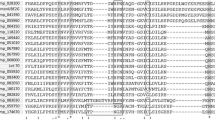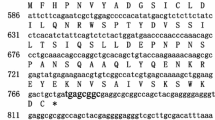Abstract
Full-length genes representing different isoforms of the ubiquitin-conjugating enzyme UBC-2 were isolated from Oesophagostomum dentatum, cloned and sequenced. The alignment of their sequences (designated Od-ubc-2.1 to Od-ubc-2.3) revealed nucleotide variation at three positions within the predicted open reading frame of 444 bp. Substitutions were at positions 141 (A↔G), 142 (A↔G) and 296 (T↔C). Both former substitutions resulted in amino acid changes from a glycine residue to an arginine residue, whereas the latter resulted in a change from isoleucine to threonine. Comparison of predicted OD-UBC-2 with UBC-2 (protein) homologues/orthologues from 12 other species representing nematodes, Drosophila melanogaster, Saccharomyces cerevisiae, mice and humans revealed identities between species varying from 77 to 100% at the amino acid level, and motifs associated with protein conformation and function were identified. While the function of a representative ubc-2 gene from O. dentatum could not be established in C. elegans, it is likely to play a key role in the catabolism of proteins and in the development of O. dentatum.



Similar content being viewed by others
References
Aboobaker AA, Blaxter ML (2004) Functional genomics for parasitic nematodes and platyhelminths. Trends Parasitol 20:178–184
Altschul SF, Gish W, Miller W, Myers EW, Lipman DJ (1990) Basic local alignment search tool. J Mol Biol 215:403–410
Ash LR, Orihel TC (1987) Parasites: a guide to laboratory procedures and identification. American Society of Clinical Pathologists, Chicago, p 328
Boag PR, Newton SE, Gasser RB (2001) Molecular aspects of sexual development and reproduction in nematodes and schistosomes. Adv Parasitol 50:153–198
Boag PR, Ren P, Newton SE, Gasser RB (2003) Molecular characterisation of a male-specific serine/threonine phosphatase from Oesophagostomum dentatum (Nematoda: Strongylida), and functional characterization of homologues in Caenorhabditis elegans. Int J Parasitol 33:313–325
Cottee PA, Nisbet AJ, Boag PR, Larsen M, Gasser RB (2004) Characterisation of major sperm protein genes and their expression in Oesophagostomum dentatum (Nematoda: Strongylida). Parasitology 129:479–490
Cottee PA, Nisbet AJ, Abs EL-Osta YG, Webster TL, Gasser RB (2006) Construction of gender-enriched cDNA archives for adult Oesophagostomum dentatum by suppressive–subtractive hybridization and microarray analysis of expressed sequence tags. Parasitology (in press)
Daugschies A, Watzel C (1999) In vitro development of histotropic larvae of Oesophagostomum dentatum under various conditions of cultivation. Parasitol Res 85:158–161
Fang S, Weissmann AM (2004) A field guide to ubiquitylation. Cell Mol Life Sci 61:1546–1561
Frazier T, Shake D, Hota U, Boyd L (2004) Caenorhabditis elegans UBC-2 functions with the anaphase-promoting complex but also has other activities. J Cell Sci 117:5427–5435
Golden A, Sadler PL, Wallenfang MR, Schumacher JM, Hamill DR, Bates G, Bowerman B, Seydoux G, Shakes DC (2000) Metaphase to anaphase (mat) transition-defective mutants in Caenorhabditis elegans. J Cell Biol 151:1469–1482
Gudgen M, Chandrasekaran A, Fraizer T, Boyd L (2004) Interactions within the ubiquitin pathway of Caenorhabditis elegans. Biochem Biophys Res Commun 325:479–486
Haas AL, Siepmann TJ (1997) Pathways of ubiquitin conjugation. FASEB J 11:1257–1268
Hartmann-Petersen R, Seeger M, Gordon C (2003) Transferring substrates to the 26S proteasome. Trends Biochem Sci 28:26–31
Haupt W (1966) Ein Beitrag zur Morphologie der Knöetchenwüermer des Hausschweines, ihrer Eier sowie der dritten invasiönstuechtigen Larvenstadien. Arch Exp Vet Med 20:701–711
Hussein AS, Harel M, Selkirk ME (2002) A distinct family of acetylcholinesterases is secreted by Nippostrongylus brasiliensis. Mol Biochem Parasitol 123:125–134
Islam MK, Miyoshi T, Yamada M, Tsuji N (2005) Pyrophosphatase of the roundworm Ascaris suum plays an essential role in the worm’s molting and development. Infect Immun 73:1995–2004
Issa Z, Grant WN, Stasiuk S, Shoemaker CB (2005) Development of methods for RNA interference in the sheep gastrointestinal parasite, Trichostrongylus colubriformis. Int J Parasitol 35:935–940
Jones D, Crowe E, Stevens TA, Candido EPM (2004) Functional and phylogenetic analysis of the ubiquitylation system in Caenorhabditis elegans: ubiquitin-conjugating enzymes, ubiquitin-activating enzymes, and ubiquitin-like proteins. Genome Biol 3(1):research0002.1–research0002.15
Kamath RS, Fraser AG, Dong Y, Poulin G, Durbin R, Gotta M, Kanapin A, Le Bot N, Moreno S, Sohrmann M, Welchman DP, Zipperlen P, Ahringer J (2003) Systematic functional analysis of the Caenorhabditis elegans genome using RNAi. Nature 421:231–237
Lustigman S, Zhang J, Liu J, Oksov Y, Hashmi S (2004) RNA interference targeting cathepsin L and Z-like cysteine proteases of Onchocerca volvulus confirmed their essential function during L3 molting. Mol Biochem Parasitol 138:165–170
Miller J, Gordon C (2003) The regulation of proteasome degradation by multi-ubiquitin chain binding proteins. FEBS Lett 579:3224–3230
Pickart C (1997) Targeting of substrates to the 26S proteasome. FASEB J 11:1055–1066
Roos-Mattjus P, Sistonen L (2004) The ubiquitin–proteasome pathway. Ann Med 36:285–295
Rual JF, Ceron J, Koreth J, Hao T, Nicot AS, Hirozane-Kishikawa T, Vandenhaute J, Orkin SH, Hill DE, van den Heuvel S, Vidal M (2004) Toward improving Caenorhabditis elegans phenome mapping with an ORFeome-based RNAi library. Genome Res 14:2162–2168
Schnell J, Hinke L (2003) Non traditional functions of ubiquitin and ubiquitin-binding proteins. J Biol Chem 258:35857–35860
Seufert W, Jentsch S (1990) Ubiquitin-conjugating enzymes UBC4 and UBC-5 mediate selective degradation of short-lived and abnormal proteins. EMBO J 9:543–550
Simmer F, Moorman C, van der Linden AM, Kuijk E, van den Berghe PV, Kamath RS, Fraser AG, Ahringer J, Plasterk RH (2003) Genome-wide RNAi of C. elegans using the hypersensitive rrf-3 strain reveals novel gene functions. PLoS Biol 1:77–84
Slotved HC, Barnes EH, Bjørn H, Christensen CM, Eriksen L, Roepstorff A, Nansen P (1996) Recovery of Oesophagostomum dentatum from pigs by isolation of parasites migrating from large intestinal contents embedded in agar-gel. Vet Parasitol 63:237–245
Sonnichsen B, Koski LB, Walsh A, Marschall P, Neumann B, Brehm M, Alleaume AM, Artelt J, Bettencourt P, Cassin E, Hewitson M, Holz C, Khan M, Lazik S, Martin C, Nitzsche B, Ruer M, Stamford J, Winzi M, Heinkel R, Roder M, Finell J, Hantsch H, Jones SJ, Jones M, Piano F, Gunsalus KC, Oegema K, Gonczy P, Coulson A, Hyman AA, Echeverri CJ (2005) Full-genome RNAi profiling of early embryogenesis in Caenorhabditis elegans. Nature 434:462–469
Talvik H, Christensen CM, Joachim A, Roepstorff A, Bjørn H, Nansen P (1997) Prepatent periods of different Oesophagostomum spp. isolates in experimentally infected pigs. Parasitol Res 83:563–568
Thompson JD, Higgins DG, Gibson TJ (1994) CLUSTAL W: improving the sensitivity of progressive multiple sequence alignment through sequence weighting, position-specific gap penalties and weight matrix choice. Nucleic Acids Res 22:4673–4680
Treier M, Seufert W, Jentsch S (1992) Drosophila UbcD1 encodes a highly conserved ubiquitin-conjugating enzyme involved in selective protein degradation. EMBO J 11:367–372
Watanabe TK, Kawai A, Fujiwara T, Maekawa H, Hirai Y, Nakamura Y, Takahashi E (1996) Molecular cloning of UBE2G, encoding a human skeletal muscle-specific ubiquitin-conjugating enzyme homologus to UBC7 of C. elegans. Cytogenet Cell Genet 74:146–148
Zhen M, Heinlein R, Jones D, Jentsch S, Candido EPM (1993) The ubc-2 gene of Caenorhabditis elegans encodes an ubiquitin-conjugating enzyme involved in selective protein degradation. Mol Cell Biol 13:1371–1377
Acknowledgements
The authors sincerely thank Professor Anja Joachim (University of Veterinary Medicine) and Niels-Peter Hansen (Danish Centre of Experimental Parasitology) for producing O. dentatum and for support. Mark Pellegrino is thanked for his assistance with gene silencing experiments in C. elegans. P.A.C. was the recipient of a scholarship from The University of Melbourne. This study was supported by grants from the Australian Research Council (Linkage Project IDs LP0346983 and LP0667795), Genetic Technologies Limited and Meat and Livestock Australia (project AHW.022). Experiments described in this paper have been performed in accordance to the laws and regulations of Australia.
Author information
Authors and Affiliations
Corresponding author
Additional information
The nucleotide sequences reported in this article have been deposited in the European Molecular Biology Laboratory, GenBank and DDJB databases under accession numbers AM181593-AM1181595.
Rights and permissions
About this article
Cite this article
Cottee, P.A., Abs EL-Osta, Y.G., Nisbet, A.J. et al. Ubiquitin-conjugating enzyme genes in Oesophagostomum dentatum . Parasitol Res 99, 119–125 (2006). https://doi.org/10.1007/s00436-005-0111-x
Received:
Accepted:
Published:
Issue Date:
DOI: https://doi.org/10.1007/s00436-005-0111-x




